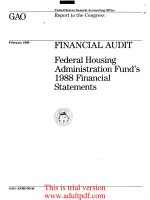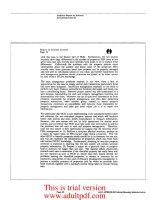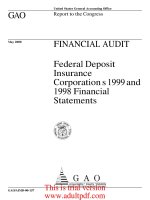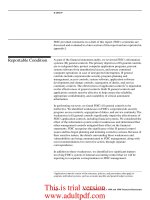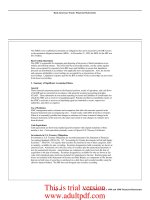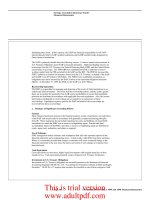United States General Accounting Office GAO February 2000 Report to the Secretary of the Treasury_part8 pdf
Bạn đang xem bản rút gọn của tài liệu. Xem và tải ngay bản đầy đủ của tài liệu tại đây (29.27 KB, 1 trang )
Financial Statements
Page 76 GAO/AIMD-00-76 IRS’ Fiscal Year 1999 Financial Statements
Internal Revenue Service
Notes to the Financial Statements
For the Fiscal Year Ended September 30, 1999
-9-
Note 1.
Summary of
Significant
Accounting
Policies
(Continued)
F. Accounts Receivable, Net
Accounts receivable consists of amounts due from federal agencies, state and local governments, and the public.
The balance of accounts receivable for reimbursable services includes both billed and unbilled receivables.
Unbilled accounts receivable are recorded, and reimbursable revenues are recognized, as the services are
performed and costs are incurred. The unbilled receivables are later transferred to billed accounts receivable
when bills are rendered to the buying agencies. The allowance for doubtful accounts is based on an annual
review of groups of accounts by region, age and account type and includes accounts receivable balances older
than one year.
G. Advances
Advances to government agencies primarily represent funds paid to the Treasury Working Capital Fund (WCF).
Amounts in the fund are available for expenses of operating and maintaining common administrative services of
Treasury that can be performed more economically as a centralized service. Centralized services funded through
the Treasury WCF for the Service consist primarily of telecommunications services and payroll processing. In
accordance with established WCF procedures, Treasury Departmental Offices collect funds for these services in
advance from Treasury Bureaus. Advances are expensed as services are provided by the WCF. This account
also includes amortized advances representing assets with a useful life greater than one year.
The majority of advances to the public are for investigations and employee travel advances, which are expensed
upon receipt of required expense reports.
H. Property and Equipment
The balances for certain categories of Property and Equipment as of September 30, 1999 were derived based
upon estimates of the net book value of a statistically selected sample of assets, using techniques prescribed by
the Uniform Standards of Appraisal Practice. These estimated net book values were then projected to the entire
population of assets. Reported balances for equipment held under capital leases, leasehold improvements, other
major systems costs and vehicles and investigative equipment of the Treasury Inspector General for Tax
Administration (TIGTA) are based upon historical costs less estimated depreciation at September 30, 1999.
Property and equipment includes ADP equipment, telecommunications equipment, office equipment and
furniture, investigative equipment and vehicles. This category comprises ADP and telecommunications
equipment acquired in connection with major systems projects, as discussed below. It includes property held
under capital leases as well as purchased assets. With the exception of small expendable computer peripherals
such as keyboards and cables, all property and equipment is capitalized regardless of the dollar amount of
individual assets.
In accordance with Office of Management and Budget guidance, the Service capitalizes costs incurred in
connection with major systems projects. The Service has identified five major systems projects: the Mainframe
Consolidation Project; the Integrated Remittance and Submission Processing System; the Call Router System,
the Case Processing System; and the Electronic Filing System. ADP and telecommunications equipment for
major systems including hardware, software, transportation charges and installation costs are capitalized with
general property and equipment as discussed above. In addition to these equipment acquisition costs, other costs
such as labor and certain indirect costs for the design, acquisition, and implementation of major systems are
capitalized separately as other major systems costs, while costs associated with preparation of facilities to house
the systems are classified as leasehold improvements. Other major systems costs are capitalized without regard
to a dollar threshold. A $50,000 threshold is used for leasehold improvements.
Property and equipment of the Treasury Inspector General for Tax Administration (TIGTA), primarily vehicles
and investigative equipment, is capitalized on the Service’s financial statements in FY 1999. TIGTA property is
capitalized without regard to a dollar threshold. See Note 1.I. below for a more complete discussion of TIGTA.
This is trial version
www.adultpdf.com
